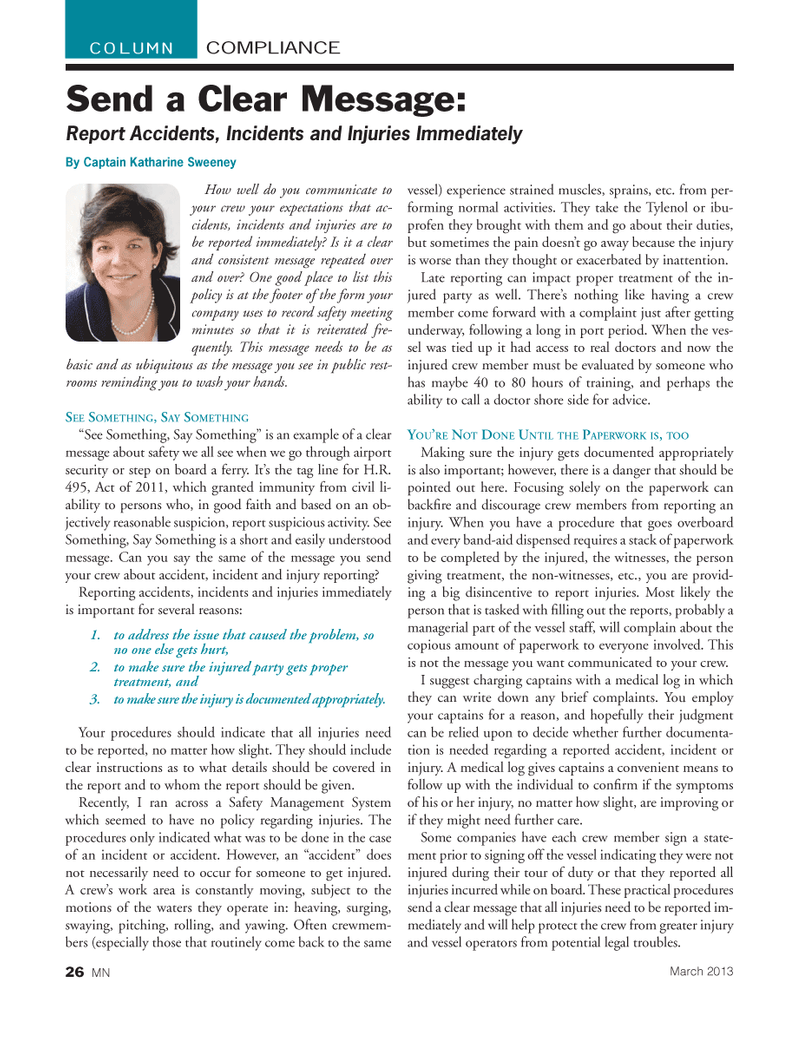
Page 26: of Marine News Magazine (March 2013)
Shipyard Report: Construction & Repair
Read this page in Pdf, Flash or Html5 edition of March 2013 Marine News Magazine
How well do you communicate to your crew your expectations that ac- cidents, incidents and injuries are to be reported immediately? Is it a clear and consistent message repeated over and over? One good place to list this policy is at the footer of the form your company uses to record safety meeting minutes so that it is reiterated fre- quently. This message needs to be as basic and as ubiquitous as the message you see in public rest- rooms reminding you to wash your hands. SEE SOMETHING, SAY SOMETHING?See Something, Say Something? is an example of a clear message about safety we all see when we go through airport security or step on board a ferry. It?s the tag line for H.R. 495, Act of 2011, which granted immunity from civil li- ability to persons who, in good faith and based on an ob-jectively reasonable suspicion, report suspicious activity. See Something, Say Something is a short and easily understood message. Can you say the same of the message you send your crew about accident, incident and injury reporting? Reporting accidents, incidents and injuries immediately is important for several reasons: 1. to address the issue that caused the problem, so no one else gets hurt, 2. to make sure the injured party gets proper treatment, and 3. to make sure the injury is documented appropriately. Your procedures should indicate that all injuries need to be reported, no matter how slight. They should include clear instructions as to what details should be covered in the report and to whom the report should be given. Recently, I ran across a Safety Management System which seemed to have no policy regarding injuries. The procedures only indicated what was to be done in the case of an incident or accident. However, an ?accident? does not necessarily need to occur for someone to get injured. A crew?s work area is constantly moving, subject to the motions of the waters they operate in: heaving, surging, swaying, pitching, rolling, and yawing. Often crewmem- bers (especially those that routinely come back to the same vessel) experience strained muscles, sprains, etc. from per- forming normal activities. They take the Tylenol or ibu- profen they brought with them and go about their duties, but sometimes the pain doesn?t go away because the injury is worse than they thought or exacerbated by inattention. Late reporting can impact proper treatment of the in- jured party as well. There?s nothing like having a crew member come forward with a complaint just after getting underway, following a long in port period. When the ves- sel was tied up it had access to real doctors and now the injured crew member must be evaluated by someone who has maybe 40 to 80 hours of training, and perhaps the ability to call a doctor shore side for advice. YOU?RE NOT DONE UNTIL THE PAPERWORK IS, TOO Making sure the injury gets documented appropriately is also important; however, there is a danger that should be pointed out here. Focusing solely on the paperwork can back re and discourage crew members from reporting an injury. When you have a procedure that goes overboard and every band-aid dispensed requires a stack of paperwork to be completed by the injured, the witnesses, the person giving treatment, the non-witnesses, etc., you are provid- ing a big disincentive to report injuries. Most likely the person that is tasked with lling out the reports, probably a managerial part of the vessel staff, will complain about the copious amount of paperwork to everyone involved. This is not the message you want communicated to your crew. I suggest charging captains with a medical log in which they can write down any brief complaints. You employ your captains for a reason, and hopefully their judgment can be relied upon to decide whether further documenta- tion is needed regarding a reported accident, incident or injury. A medical log gives captains a convenient means to follow up with the individual to con rm if the symptoms of his or her injury, no matter how slight, are improving or if they might need further care. Some companies have each crew member sign a state- ment prior to signing off the vessel indicating they were not injured during their tour of duty or that they reported all injuries incurred while on board. These practical procedures send a clear message that all injuries need to be reported im- mediately and will help protect the crew from greater injury and vessel operators from potential legal troubles. COMPLIANCECOLUMNSend a Clear Message: Report Accidents, Incidents and Injuries Immediately By Captain Katharine Sweeney26 MNMarch 2013 MN March2013 Layout 18-31.indd 26MN March2013 Layout 18-31.indd 263/1/2013 11:14:45 AM3/1/2013 11:14:45 AM

 25
25

 27
27
